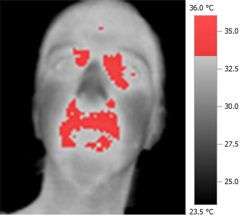How the merest social contact with a man can make a woman glow
(Medical Xpress) -- Researchers at the University of St Andrews found that non-sexual social interactions with men caused a noticeable rise in the temperature of a woman's face, without them even noticing.
The research was conducted by Amanda Hahn, Carmen Lefevre and David Perrett from the University's Perception Lab. The team used thermal imaging to monitor temperature changes in women during interactions with a man or another woman.
The findings could be important for the development of thermal imaging in monitoring changes in levels of stress and emotion, for example in lie detection tests, where the merest increase in temperature would be picked up.
Lead author Amanda Hahn, explained, "We used a thermal camera to record skin temperature during a standard 'social interaction' where we measured participants' skin colour at 'non-personal' (i.e. the arm and palm of the hand) and 'personal' (i.e. the face and chest) locations on the body. The thermal response was dramatic when the male experimenter made contact at 'personal' locations."
While it may not be surprising that people have a physiological response to social contact, the size of the reaction was surprising. Hahn commented, "We observed some women whose facial temperature increased by an entire degree (Celsius) during interaction with the male experimenter.
"This thermal change was in response to simple social interaction, without any experimental change to emotion or arousal. Indeed our participants did not report feeling embarrassment or discomfort during the interaction."
The study, published later this month in Biology Letters, shows that gender alone influenced the reaction of women, who showed no response to interaction with other women.
Professor David Perrett, who runs the Perception Lab added, "This finding is interesting and important for future work. Thermal imaging is a relatively new technique employed to monitor emotion and stress. We are only just beginning to understand the potential uses of thermal imaging in medicine and it can be very useful in areas of national security, where changes in skin temperature can be gauged as part of lie detection tests."
The research team’s next goal is to work out whether or not these physiological changes are detected by others and whether they affect social interactions. Study co-author Carmen Lefevre concluded, "We are currently exploring the link between changes in skin temperature and skin colour. A slight increase in blood flow may cause the skin temperature to rise; this increase in blood flow may also cause the skin to become redder. We do not yet know if these changes are evident to others or how they affect perceptions of attractiveness."
More information: Hot or not? Thermal reactions to social contact, Biology Letters, Published online before print May 30, 2012, doi: 10.1098/rsbl.2012.0338
Abstract
Previous studies using thermal imaging have suggested that face and body temperature increase during periods of sexual arousal. Additionally, facial skin temperature changes are associated with other forms of emotional arousal, including fear and stress. This study investigated whether interpersonal social contact can elicit facial temperature changes. Study 1: infrared images were taken during a standardized interaction with a same- and opposite-sex experimenter using skin contact in a number of potentially high–intimate (face and chest) and low–intimate (arm and palm) locations. Facial skin temperatures significantly increased from baseline during the face and chest contact, and these temperature shifts were larger when contact was made by an opposite-sex experimenter. Study 2: the topography of facial temperature change was investigated in five regions: forehead, periorbital, nose, mouth and cheeks. Increased temperature in the periorbital, nose and mouth regions predicted overall facial temperature shifts to social contact. Our findings demonstrate skin temperature changes are a sensitive index of arousal during interpersonal interactions.
Journal information: Biology Letters
Provided by University of St Andrews




















